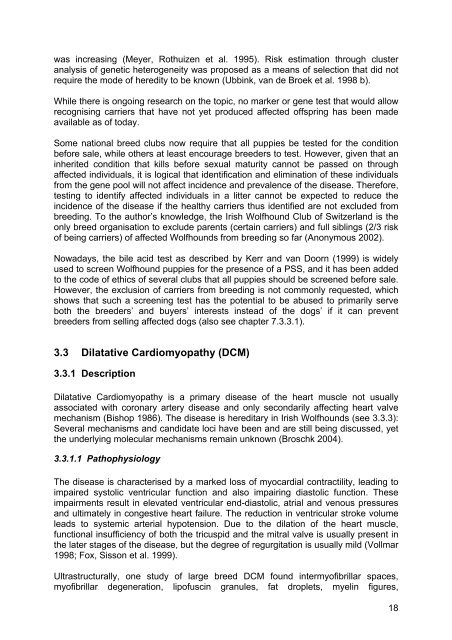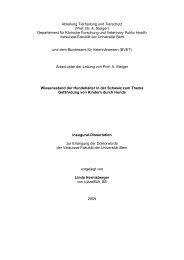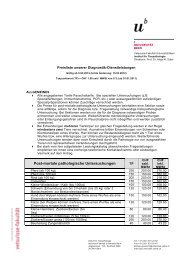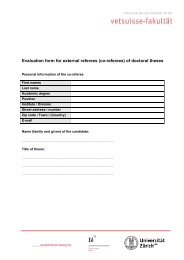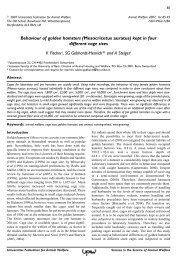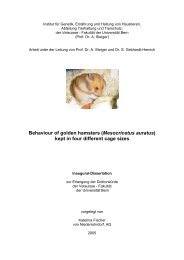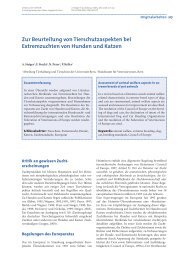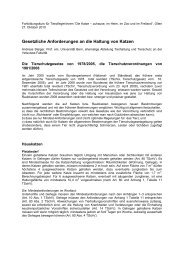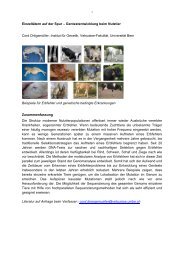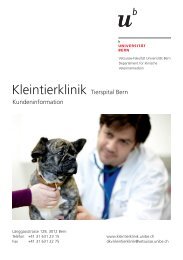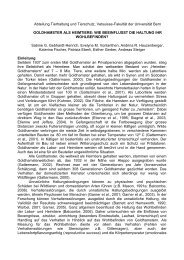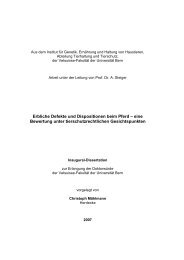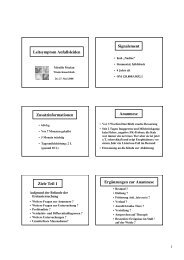Lifespan and Causes of Death in the Irish Wolfhound - Vetsuisse ...
Lifespan and Causes of Death in the Irish Wolfhound - Vetsuisse ...
Lifespan and Causes of Death in the Irish Wolfhound - Vetsuisse ...
You also want an ePaper? Increase the reach of your titles
YUMPU automatically turns print PDFs into web optimized ePapers that Google loves.
was <strong>in</strong>creas<strong>in</strong>g (Meyer, Rothuizen et al. 1995). Risk estimation through cluster<br />
analysis <strong>of</strong> genetic heterogeneity was proposed as a means <strong>of</strong> selection that did not<br />
require <strong>the</strong> mode <strong>of</strong> heredity to be known (Ubb<strong>in</strong>k, van de Broek et al. 1998 b).<br />
While <strong>the</strong>re is ongo<strong>in</strong>g research on <strong>the</strong> topic, no marker or gene test that would allow<br />
recognis<strong>in</strong>g carriers that have not yet produced affected <strong>of</strong>fspr<strong>in</strong>g has been made<br />
available as <strong>of</strong> today.<br />
Some national breed clubs now require that all puppies be tested for <strong>the</strong> condition<br />
before sale, while o<strong>the</strong>rs at least encourage breeders to test. However, given that an<br />
<strong>in</strong>herited condition that kills before sexual maturity cannot be passed on through<br />
affected <strong>in</strong>dividuals, it is logical that identification <strong>and</strong> elim<strong>in</strong>ation <strong>of</strong> <strong>the</strong>se <strong>in</strong>dividuals<br />
from <strong>the</strong> gene pool will not affect <strong>in</strong>cidence <strong>and</strong> prevalence <strong>of</strong> <strong>the</strong> disease. Therefore,<br />
test<strong>in</strong>g to identify affected <strong>in</strong>dividuals <strong>in</strong> a litter cannot be expected to reduce <strong>the</strong><br />
<strong>in</strong>cidence <strong>of</strong> <strong>the</strong> disease if <strong>the</strong> healthy carriers thus identified are not excluded from<br />
breed<strong>in</strong>g. To <strong>the</strong> author’s knowledge, <strong>the</strong> <strong>Irish</strong> <strong>Wolfhound</strong> Club <strong>of</strong> Switzerl<strong>and</strong> is <strong>the</strong><br />
only breed organisation to exclude parents (certa<strong>in</strong> carriers) <strong>and</strong> full sibl<strong>in</strong>gs (2/3 risk<br />
<strong>of</strong> be<strong>in</strong>g carriers) <strong>of</strong> affected <strong>Wolfhound</strong>s from breed<strong>in</strong>g so far (Anonymous 2002).<br />
Nowadays, <strong>the</strong> bile acid test as described by Kerr <strong>and</strong> van Doorn (1999) is widely<br />
used to screen <strong>Wolfhound</strong> puppies for <strong>the</strong> presence <strong>of</strong> a PSS, <strong>and</strong> it has been added<br />
to <strong>the</strong> code <strong>of</strong> ethics <strong>of</strong> several clubs that all puppies should be screened before sale.<br />
However, <strong>the</strong> exclusion <strong>of</strong> carriers from breed<strong>in</strong>g is not commonly requested, which<br />
shows that such a screen<strong>in</strong>g test has <strong>the</strong> potential to be abused to primarily serve<br />
both <strong>the</strong> breeders’ <strong>and</strong> buyers’ <strong>in</strong>terests <strong>in</strong>stead <strong>of</strong> <strong>the</strong> dogs’ if it can prevent<br />
breeders from sell<strong>in</strong>g affected dogs (also see chapter 7.3.3.1).<br />
3.3 Dilatative Cardiomyopathy (DCM)<br />
3.3.1 Description<br />
Dilatative Cardiomyopathy is a primary disease <strong>of</strong> <strong>the</strong> heart muscle not usually<br />
associated with coronary artery disease <strong>and</strong> only secondarily affect<strong>in</strong>g heart valve<br />
mechanism (Bishop 1986). The disease is hereditary <strong>in</strong> <strong>Irish</strong> <strong>Wolfhound</strong>s (see 3.3.3):<br />
Several mechanisms <strong>and</strong> c<strong>and</strong>idate loci have been <strong>and</strong> are still be<strong>in</strong>g discussed, yet<br />
<strong>the</strong> underly<strong>in</strong>g molecular mechanisms rema<strong>in</strong> unknown (Broschk 2004).<br />
3.3.1.1 Pathophysiology<br />
The disease is characterised by a marked loss <strong>of</strong> myocardial contractility, lead<strong>in</strong>g to<br />
impaired systolic ventricular function <strong>and</strong> also impair<strong>in</strong>g diastolic function. These<br />
impairments result <strong>in</strong> elevated ventricular end-diastolic, atrial <strong>and</strong> venous pressures<br />
<strong>and</strong> ultimately <strong>in</strong> congestive heart failure. The reduction <strong>in</strong> ventricular stroke volume<br />
leads to systemic arterial hypotension. Due to <strong>the</strong> dilation <strong>of</strong> <strong>the</strong> heart muscle,<br />
functional <strong>in</strong>sufficiency <strong>of</strong> both <strong>the</strong> tricuspid <strong>and</strong> <strong>the</strong> mitral valve is usually present <strong>in</strong><br />
<strong>the</strong> later stages <strong>of</strong> <strong>the</strong> disease, but <strong>the</strong> degree <strong>of</strong> regurgitation is usually mild (Vollmar<br />
1998; Fox, Sisson et al. 1999).<br />
Ultrastructurally, one study <strong>of</strong> large breed DCM found <strong>in</strong>termy<strong>of</strong>ibrillar spaces,<br />
my<strong>of</strong>ibrillar degeneration, lip<strong>of</strong>usc<strong>in</strong> granules, fat droplets, myel<strong>in</strong> figures,<br />
18


